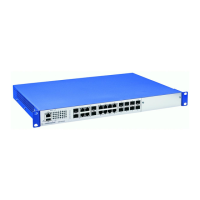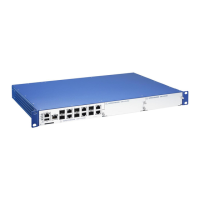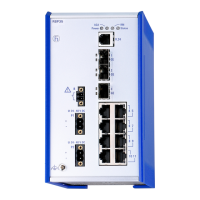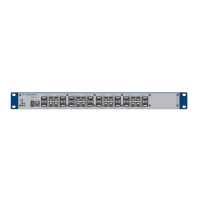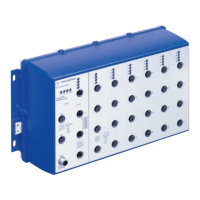34
Installation GRS103
Release
01
03/2022
5.5 Ethernet ports
You can connect end devices and other segments to the device ports using
twisted pair cables or optical fibers (F/O).
5.5.1 10/100 Mbit/s twisted pair port
This port is an RJ45 socket.
The 10/100 Mbit/s twisted pair port allows you to connect network
components according to the IEEE 802.3 10BASE-T/100BASE-TX standard.
This port supports:
Autonegotiation
Autopolarity
Autocrossing (if autonegotiation is activated)
100 Mbit/s half-duplex mode, 100 Mbit/s full duplex mode
10 Mbit/s half-duplex mode, 10 Mbit/s full duplex mode
Delivery state: Autonegotiation activated
The port casing is electrically connected to the front panel.
5.5.2 10/100 Mbit/s PoE port
This port is an RJ45 socket.
The 10/100 Mbit/s PoE port allows you to connect network components as a
PoE voltage sink according to the standard IEEE 802.3 10BASE-T/
100BASE-TX and IEEE 802.3af/IEEE 802.3at.
This port supports:
Autonegotiation
Autopolarity
Autocrossing (if autonegotiation is activated)
100 Mbit/s half-duplex mode, 100 Mbit/s full duplex mode
10 Mbit/s half-duplex mode, 10 Mbit/s full duplex mode
Power over Ethernet (PoE)
Delivery state: Autonegotiation activated
The port casing is electrically connected to the front panel.
The PoE power is supplied via the wire pairs transmitting the signal (phantom
voltage).
Pin Function
1 RD+ Receive path
2 RD- Receive path
3 TD+ Transmission path
6 TD- Transmission path
4, 5, 7, 8 –
Table 10: Pin assignment 10/100 Mbit/s twisted pair port, RJ45 socket, MDI-X mode

